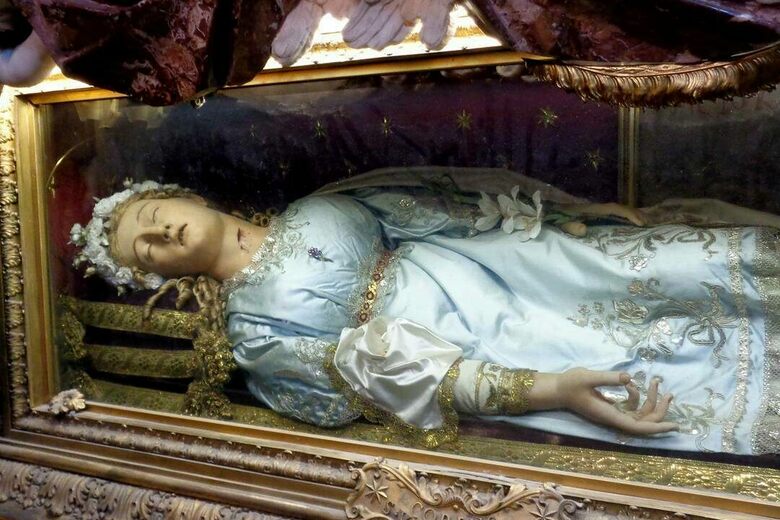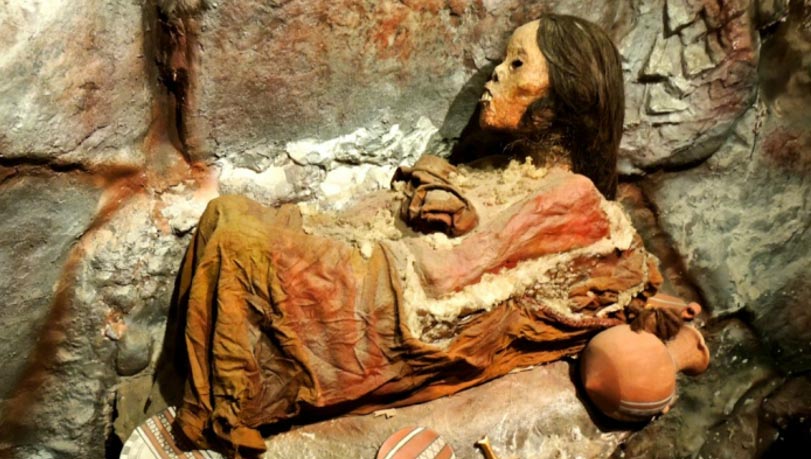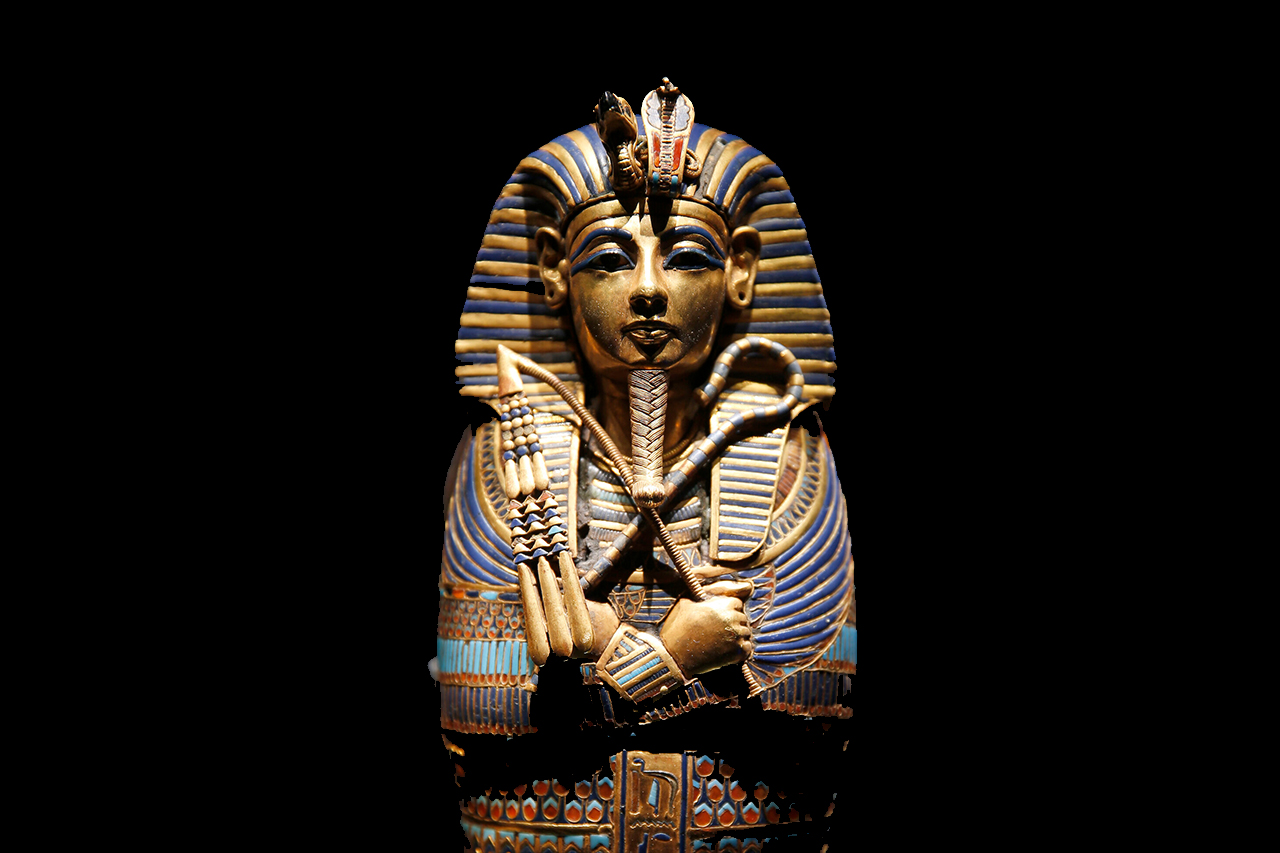BODIES THAT DO NOT DECAY; A RIDDLE FOR SCIENTISTS?

While bodies preserved intentionally in various cultures over the years for religious purposes and those preserved automatically owing to natural laws should not pose an enigma for researchers, incorruptible bodies of Christian saints, often accompanied with strange phenomena, have intrigued scientists.
Loulan was an ancient kingdom, located around an oasis city of importance along the Silk Road,-the famous trade route linking the East and West, from the 2nd century B. C. to the 18th century-on the northeastern edge of the Lop desert. The ruins of Loulan are found now in Xinjiang province, an autonomous region of the People’s Republic of China. At present they are completely surrounded by desert. In 1981, in this province, an incorrupt body of a female, called “The Young Lady of Loulan”, was unearthed. The discovery is sensational in that this 6470-year-old mummy is claimed to be the oldest in the world, even predating the mummies of ancient Egypt.
Kano, located in northern Nigeria and south of the Sahara, is the second most populous city in the country next to Lagos, the capital. Islam arrived in the city in the 11th century or earlier mainly through the Trans-Saharan trade, with travellers crossing the Sahara between sub-Saharan Africa and predominantly Muslim North Africa. A self-styled prophet, named Muhammadu Marwa, had founded a heretical Muslim cult in 1960s with a large gathering of followers who had numbered nearly 10,000. But the new sect did not seem to usher in a period of peace in the country, as the tension was brewing between the heretics and the orthodox Muslims who were against the new religious leader. Finally the tension exploded in December 1980 when a violent riot broke out in which some 8000 people, along with the cult leader, were killed. Marwa’s followers interred him in a shallow grave, but due to the immense respect the people had for him, his body was exhumed after three weeks on the order of the Governor and placed on ice in the city mortuary. Although the body remained buried for three weeks, it was incorrupt, which led the people to consider it a miracle.
Another similar story was reported from Italy. A two-year-old girl by the name of Nadja Mattei died in 1965 in Rome. But for 12 years the grieving mother continuously dreamt that her daughter was pleading with her to be taken out of the coffin. After a lot of futile efforts by the mother to convince the authorities to let her reopen the coffin, finally, in 1977, the approval was granted. Those who were present at the exhumation of the body, were stupefied with amazement by seeing that the body of baby Nadja had not decayed.
Author Joan Carroll Cruz wrote a very informative book (1977) on this subject, entitled The Incorruptibles in which the incorrupt bodies were categorised into three types: 1. Bodies preserved deliberately and intentionally for a specific purpose. 2. Bodies preserved accidentally, unintentionally or naturally. 3. Bodies that have resisted decay for centuries defying all rational explanations, which the author calls the true Incorruptibles that are often accompanied with strange phenomena. The bodies of many medieval saints and martyrs of the Roman Catholic and Eastern Orthodox Churches fall into this last category.

Category 1:
In ancient Egypt dead bodies of royalty were intentionally mummified by eviscerating, stuffing of the evacuated bodily cavities, embalming and wrapping them in cloth for a religious purpose: preparation of the deceased for the afterlife. Yet, the artificial South American mummies of Chinchorro culture of sedentary fishermen (from 9000 to 3500 B. C.), inhabiting what is now northern Chile, antedate these Egyptian mummies by 2000 years. The internal organs and skin of the bodies were removed prior to exposing them to the hot and dry climate of the Atacama Desert, which facilitated desiccation.
The mummified body of a 2 ½ -year-old infant was discovered by Italian archeologist Fabrizio Mori in a natural cave of Uan Muhuggiag, an ancient archaeological site in Libya during a 1958-1959 expedition. The radiocarbon-dated mummy was supposed to be over 5000 years old.
Mummies in the Philippines are called Fire Mummies or Kabayan Mummies, found along the mountain slopes of the town of Kabayan. They are common in the culture and heritage of the Igorot people from Northern Luzon. These mummies are dated between the 14th and 19th centuries.
The mummies of the Canary Islands, a Spanish archipelago in the Atlantic Ocean, belong to the aboriginal Guanche people and date back to the time before Spanish explorers settled in the area in the 14th century. All deceased people within the Guanche culture were mummified though the level of care taken in the process varied depending on the social status of the individuals.
In 1994, 265 mummified bodies, dating to the 1729-1838 period, were found in the crypt of a Dominican church in Vác, Hungary. The mummies were scientifically important and by 2006 an exhibition was held in the Museum of Natural History in Budapest. Unique to the Hungarian mummies are their elaborately decorated coffins, with no two mummies looking exactly alike.
A mummy, estimated to be around 2000 years old, was found in 1999 by Dr. Johan Binneman in South Africa in the Baviaanskloof (Dutch for Baboons’ Gap) Protected Area, about 95 km northwest of the coastal city of Port Elizabeth. This first mummy to be discovered in the country was linked to the indigenous Khoikhoi culture of the region. The Khoikhoi people, historically referred to as Hottentots, are traditional non-Bantu nomadic pastoralists.
The Aztecs in pre-Columbian Mexico practised deliberate mummification while some Maori tribes from New Zealand kept mummified heads, known as Mokomokai, as trophies from tribal warfare.
Category 2:
The 16th century incorrupt bodies of the Capuchin (Franciscan) monks, hanging like broken dolls in the catacombs in Palermo, Sicily, Italy, offering a ghastly sight to the visiting tourists, are well-known. The researchers found that the air in these underground cemeteries has the peculiar property of drying out the bodies and turning them into natural mummies. The Capuchin friars, interred in their underground crypt in Brno, Czech Republic 300 years ago, withstood decay owing to the geological composition of the topsoil and the unique air quality inside the crypt. The special vaults of St. Michan’s Church in Dublin, Ireland, dating from 1095 A. D., contain limestone which has kept the air dry and free from dust, creating excellent conditions for preservation. In 2019 some mummified remains in the crypts in this church were reportedly desecrated by vandals, including the remains of a 400-year-old nun and the decapitation of an 800-year-old crusader. In Kiev in Ukraine, Russia, where such preserving conditions prevail, many withered bodies are found lying in open coffins.
In 1954 atop El Plomo Peak in Chile, the mummy of a male child, who was presumed to be of a wealthy family due to his well-fed bodily characteristics, was discovered. The boy is believed to have been dragged there to freeze as a human sacrifice. This mummy was considered to be the most well-preserved ice mummy in the world until the discovery of Momia Juanita (Spanish for “Mummy Juanita”) in 1995. In that year Dr. Johan Reinhard, a veteran explorer and anthropologist from the National Geographic Society, headquartered in Washington, U. S. A., discovered this well-preserved frozen body of a 12-15-year-old Incan girl who may have been killed as an offering to their gods in the 15th century. The girl, also nicknamed “Lady of Ampato” and “Ice Maiden”, was found closer to the summit of the dormant stratovolcano Mount Ampato, part of the Andes in southern Peru. In 1999, near the summit of Llullaillaco, another stratovolcano on the Argentina-Chile border, Reinhard made another discovery of three mummies of children who are said to be sacrifices in an Inca ritual involving children.
In 1972 eight mummies, dating to around 500 years, were found at an abandoned Inuit (indigenous people from the Arctic regions) settlement in Greenland. The sub-zero temperatures and dry winds had caused their remarkable preservation.
In 1993 a team of Russian archaeologists, led by Dr. Natalia Polosmak, discovered a mummy of a Siberian woman from the 5th century B. C. on the Ukok Plateau in the Altai Mountains closer to the Mongolian border. The mummy was naturally frozen due to the harsh climatic conditions of the Siberian steppe.
Around 2010 in Douzlakh Salt Mine at Chehr Abad in northwestern Iran, remains of miners who had been killed due to collapse of the galleries, were found. The bodies had not decomposed due to salt and they are known as “Saltmen”.
Finally, the people from the Iron Age have been found intact in peat bogs in Denmark, Ireland and Scotland, although natural chemical processes have discoloured their corpses.
At this point, prior to dealing with the category 3, it would be appropriate to surmise whether vampirism, the belief in reanimated corpses that rise up from their graves at night to feed on fresh blood from unsuspecting humans in their sleep, could have originated mistakenly from such incorrupt cadavers that were disinterred. This belief was rife in Slavic folklore of Eastern Europe and the common method of warding off a potential vampire was staking through the heart. These tales later inspired Abraham (Bram) Stoker (1847-1912), the Irish author, to write his famous 1897 Gothic horror novel Dracula, unfolding in the Romanian region of Transylvania. Although it was fiction, its protagonist was a historic figure: the 15th-century Wallachian Prince from that country, most commonly known as Vlad the Impaler or Vlad Dracula who fought against the invading Ottoman Turks and is considered a patriot and a national hero of Romania.
Category 3:
a) Smell of Holiness, healing liquids and prodigious lights
The enigmatically incorrupt bodies in this category have not yet yielded up their secrets and do not fall into any of those bodies preserved due to mummification, elements, chemical and other explicable reasons, hence insistently begging for scientific investigation. As defined by the Catholic Church, such bodies have the “odour of sanctity” (a pleasant floral aroma) that emanates from the wounds of stigmata (crucifixion wounds of Jesus Christ). These saints are called “myroblytes”.
Giuseppe Fallica, an Italian, in Il miracolo dei corpi incorrotti (meaning The Miracle of Incorrupt Bodies), cites the case of St. Albert the Great, German Dominican friar (died in 1280), fragrant 200 years after his passing away; that of Blessed Angelo of Sansepolcro (died in 1306), very fragrant after 176 years; that of St. Rita of Cascia, Italian Augustinian nun (died in 1447), still fragrant today; and that of St. Teresa of Avila, Spanish Carmelite nun (died in 1582), fragrant after 330 years.
The main point of objection of the critics is that the smell may have been produced by balms that were used for the preservation of the body. However, according to Fallica, several elements concur to disprove this hypothesis. The sweet smell was usually released immediately after death (for example, St. Vincenzo Pallotti, Italian ecclesiastic, died in 1850; Blessed Giuseppa of Sant’Agnese, etc.).
Blessed Bernardo Scammacca, born in Catania, Sicily, was thrown into a common grave in 1487 and when it was opened to shift him to a more dignified place, his body was found intact and it released an intoxicating smell. St. Margaret Clitherow Middleton of York, England, a martyr, was tortured to death in 1586 for harbouring Catholic priests and was thrown into a pit of putrid and muddy water. Her body was found still fresh, pure and fragrant.
Fallica says that in some cases, the miracle is not limited to the body. The aroma on the body of St. Lucia of Narni, an Italian mystic and stigmatic (died in 1544), was transmitted to all the objects with which the relic came into contact during its exhibition. The perfume exuded by the corpse of St. Vincenzo Pallotti persisted for a month in the room where he had died, despite the open window.
Another theory has been proposed that this preternatural fragrance comes from acetone and/or acetoacetic acid, caused by ketosis (high level of ketone bodies in blood or urine) brought on by starvation from fasting. Yet, the bodies equally exuding an aromatic liquid, similar to myrrh, with healing properties, pose a conundrum for medical experts.
In addition to the good smell, unexplainable lights have been associated as well with these incorruptibles. When the Italian Blessed Mattia Nazzareni, the abbess of the Order of the Poor Clares, died in 1320, her body was wrapped in a beam of light besides emanating a fragrance to flood the whole monastery.
b) Permanent flexibility of the members
Fallica writes that the absence of the rigidity of the corpse is the most frequently found phenomenon in the people who have died, leading a life of sanctity.
On the death of Blessed Mary of the Passion, a French nun and missionary in 1904, her doctor testified that although the season was very hot in July in southern Italy, the body, however, was still very flexible, and despite mistreatment due to continuous touching of people, to the amazement of all, it always remained incorrupt, without giving out the slightest bad smell. It was also observed that the face became more and more beautiful and outlined.
c) Flow of fresh blood
The flow of fresh blood into the incorruptible bodies, even after an interval of weeks, months, or even years, is a fairly recurrent phenomenon, although less common than the odour of sanctity and the absence of rigor mortis.
In this regard one may mention the cases of the nosebleeds that occurred on the twenty-fourth day of the exposure of the body of St. Bernardino of Siena (died in 1444); the flow of fresh blood that came from the nostrils of St. Catherine of Bologna (died in 1463) three months after her death; and the spilling of blood generated by the amputation of a finger from the body of St. John of the Cross, Spanish Catholic priest (died in 1591), nine months after his death.
In Roman Catholicism and in the Eastern Orthodox Church an incorrupt body is mostly viewed as a sign that the individual is a saint. But this is not essentially a prerequisite for sainthood. Saints, whose bodies have undergone the natural process of decomposition, are venerated in equal manner by the faithful. ***







